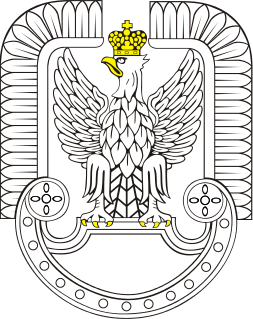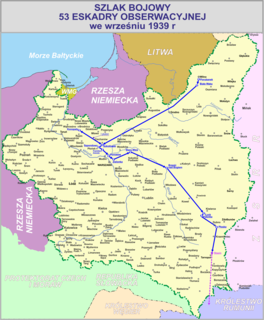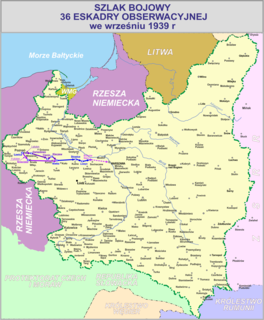Related Research Articles

The European theatre of World War II opened with the German invasion of Poland on Friday September 1, 1939, which was then followed by the Soviet invasion of Poland on September 17, 1939. The Polish Army was defeated after approximately a month of fighting. Poland never officially surrendered or conquered. After Poland had been overrun, a government-in-exile the home army or secret Polish underground state kept fighting, armed forces, and an intelligence service were established outside of Poland. These organizations contributed to the Allied effort throughout the war. The Polish Army was recreated in the West, as well as in the East.

The invasion of Poland marked the beginning of World War II. The German invasion began on 1 September 1939, one week after the signing of the Molotov–Ribbentrop Pact between Germany and the Soviet Union, and one day after the Supreme Soviet of the Soviet Union had approved the pact. The Soviets invaded Poland on 17 September. The campaign ended on 6 October with Germany and the Soviet Union dividing and annexing the whole of Poland under the terms of the German–Soviet Frontier Treaty.

The Polish Air Force is the aerial warfare military branch of the Polish Armed Forces. Until July 2004 it was officially known as Wojska Lotnicze i Obrony Powietrznej. In 2014 it consisted of roughly 16,425 military personnel and about 475 aircraft, distributed among ten bases throughout Poland.

The PZL P.7 was a Polish fighter aircraft designed in the early 1930s at the PZL factory in Warsaw. It was one of the first all-metal monoplane fighters in the world and was the main fighter of the Polish Air Force between 1933 and 1935. The PZL P.7 was replaced in Polish service by its follow-up design, the PZL P.11c. More than 30 PZL P.7 fighters remained in service during the Invasion of Poland, scoring several kills despite its obsolescence.
Josef František, was a Czechoslovak fighter pilot and Second World War fighter ace who flew for the air forces of Czechoslovakia, Poland, France, and the United Kingdom. He was the highest-scoring non-British Allied ace in the Battle of Britain, with 17 confirmed victories and one probable, all gained in a period of four weeks in September 1940.

The Bombing of Warsaw in World War II refers to the aerial bombing campaign of Warsaw by the German Luftwaffe during the siege of Warsaw in the invasion of Poland in 1939. It also may refer to German bombing raids during the Warsaw Uprising in 1944. During the course of the war approximately 85% of the city was destroyed due to German mass bombings, heavy artillery fire and a planned demolition campaign.

The Polish Air Forces was the name of the Polish Air Forces formed in France and the United Kingdom during World War II. The core of the Polish air units fighting alongside the Allies were experienced veterans of the 1939 invasion of Poland. They contributed to the Allied victory in the Battle of Britain and Allied air operations during the war.

No. 1 Group of the Royal Air Force is one of the two operations groups in RAF Air Command. Today, the group is referred to as the Air Combat Group, as it controls the RAF's combat fast-jet aircraft and has airfields in the UK, as well as RAF Support Unit Goose Bay in Canada. The group headquarters is located alongside Headquarters Air Command at RAF High Wycombe, Buckinghamshire. The other operational group is No. 2 Group RAF.

The RWD-14 Czapla was a Polish army cooperation aircraft, designed in the mid-1930s by the RWD team, and produced in the LWS factory from 1938. A series of 65 aircraft were built and most were used by the Polish Air Force observation squadrons during World War II in 1939.

Stanisław Skalski, was a Polish aviator and fighter ace who served with the Polish Air Force and British Royal Air Force during the Second World War. Skalski was the top Polish fighter ace of the war and the first Allied fighter ace of the war, credited, according to the Bajan's list, with 18 11/12 victories and two probable. Some sources, including Skalski himself, give a number of 22 11/12 victories. He returned to the Polish Air Force after the Second World War and rose to the rank of brigadier general.

The Battle of Hel was a World War II engagement fought from 1 September to 2 October 1939 on the Hel Peninsula, of the Baltic Sea coast, between invading German forces and defending Polish units during the German invasion of Poland. The defense of the Hel Peninsula took place around the Hel Fortified Area, a system of Polish fortifications that had been constructed in the 1930s near the interwar border with the German Third Reich.

The Polish Armed Forces in the West refers to the Polish military formations formed to fight alongside the Western Allies against Nazi Germany and its allies during World War II. Polish forces were also raised within Soviet territories; these were the Polish Armed Forces in the East.
The Polish Army in France formed in France under the command of General Władysław Sikorski in late 1939, after the fall of Poland resulting from the Polish Defensive War. About 85,000 troops were in the process of being organized into fighting formations when the battle of France started. The army was partially destroyed in the hostilities, but over 20,000 soldiers were evacuated and formed a new Polish army in the United Kingdom.
The 132nd Fighter Escadrille of the Polish Air Force was one of the fighter units of the Polish Army in 1939. It was attached to the Army Poznań.
The 121st Fighter Escadrille of the Polish Air Force was one of the fighter units of the Polish Army in 1939.

The 53rd Observation Escadrille was a unit of the Polish Air Force at the beginning of the Second World War. The unit was attached to the Modlin Army.

The 23rd Observation Escadrille was a unit of the Polish Air Force at the beginning of the Second World War. The unit was attached to the Kraków Army.

The 66th Observation Escadrille was a unit of the Polish Air Force at the beginning of the Second World War. The unit was attached to the Łódź Army.

The 36th Observation Escadrille was a unit of the Polish Air Force at the beginning of the Second World War. The unit was attached to the Poznań Army.
References
- Jerzy Pawlak (1982). Polskie eskadry w Wojnie Obronnej 1939 (in Polish). Warsaw: Wydawnictwa Komunikacji i Łączności. ISBN 83-206-0281-5.
| This Polish Air Force article is a stub. You can help Wikipedia by expanding it. |